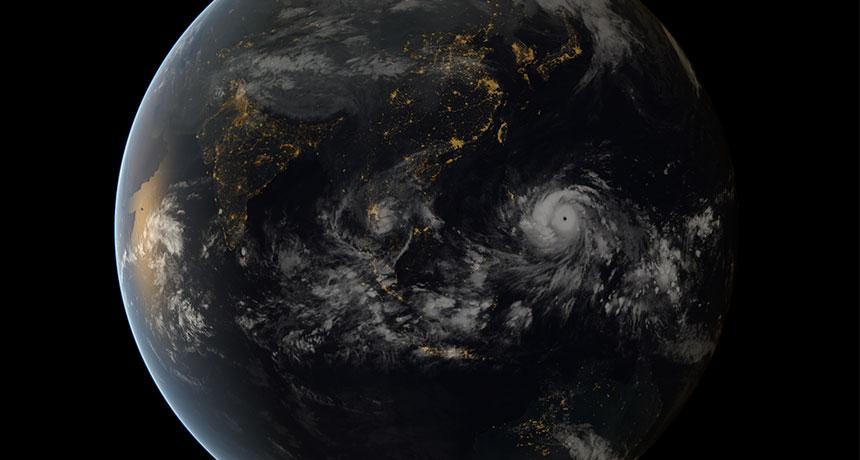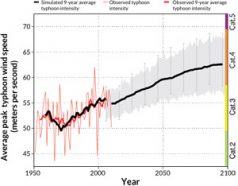Pacific hurricanes to strengthen as Earth warms
Hotter subsurface water expected to fuel bigger storms

Powerful storms such as Typhoon Haiyan, pictured at middle right in this composite image, can devastate communities on land. The average intensity of typhoons will rise by the end of the century, new research predicts.
COPYRIGHT 2013 EUMETSAT/JMA
In tropical regions around the world, huge storms form over warm ocean waters. These swirling monstrosities have different names. In the Atlantic, they’re known as hurricanes. In the Pacific, they’re called typhoons or tropical cyclones. These storms can cause massive damage when they travel over land. New research now predicts that typhoons in the Pacific will become even more destructive. That will happen because ocean waters are warming.
The prediction comes from a team led by Wei Mei. He is a climate scientist at the Scripps Institution of Oceanography in La Jolla, Calif. Mei’s team compared the formation of more than 850 past typhoons. They occurred in the western Pacific Ocean over a 60-year period.
A clear trend emerged. A typhoon’s ultimate intensity depended largely on the temperature of deep seawater. That water churns upward as the storm passes overhead. Slightly warmer waters 50 to 150 meters (160 to 490 feet) deep bolstered the strongest storm seasons.

Hurricanes and typhoons are ranked in terms of the category of their wind speeds. The predicted increase in winds is enough to turn a Category 3 storm into a Category 4, notes Mei. That’s the difference between a storm that is considered “devastating” and one that is “catastrophic.”
Faster winds spell trouble for anyone in a storm’s path, says Kerry Emanuel. He is an atmospheric scientist at the Massachusetts Institute of Technology in Cambridge, who was not involved with the research. “A 14 percent increase in wind speed is an almost 50 percent increase in destructiveness,” he notes.
This isn’t the final word on future typhoon intensity, says Thomas Knutson. He is a climate scientist at the National Oceanic and Atmospheric Administration’s Geophysical Fluid Dynamics Laboratory. It’s in Princeton, N.J. Studies initially predicted that climate change would spur much stronger hurricanes in the Atlantic. But later research cast doubt on those predictions. Interactions between the air and ocean that weren’t important during the last few decades could become more prominent in a warmed world. If that happens, Knutson says, typhoon intensity might lessen instead of increase.
Power Words
(for more about Power Words, click here)
Atlantic One of the world’s five oceans, it is second in size only to the Pacific. It separates Europe and Africa to the east from North and South America to the west.
atmosphere The envelope of gases surrounding Earth or another planet.
climate The weather conditions prevailing in an area in general or over a long period.
climate change Long-term, significant change in the climate of Earth. It can happen naturally or in response to human activities, including the burning of fossil fuels and clearing of forests.
global warming The gradual increase in the overall temperature of Earth’s atmosphere due to the greenhouse effect. This effect is caused by increased levels of carbon dioxide, chlorofluorocarbons and other gases in the air, many of them released by human activity.
hurricane A tropical cyclone that occurs in the Atlantic Ocean and has winds of 119 kilometers (74 miles) per hour or greater. When such a storm occurs in the Pacific Ocean, people refer to it as a typhoon.
Pacific The largest of the world’s five oceans. It separates Asia and Australia to the west from North and South America to the east.
roil To agitate or upset someone’s emotions. To make water or some liquid hard to see through because of some churning that has mixed sediment or something into it. To churn air currents violently, as can occur with clouds during a storm.
tropics The region near Earth’s equator. Temperatures here are generally warm to hot, year-round.
typhoon A tropical cyclone that occurs in the Pacific or Indian oceans and has winds of 119 kilometers (74 miles) per hour or greater. In the Atlantic Ocean, people refer to such storm as hurricanes.







